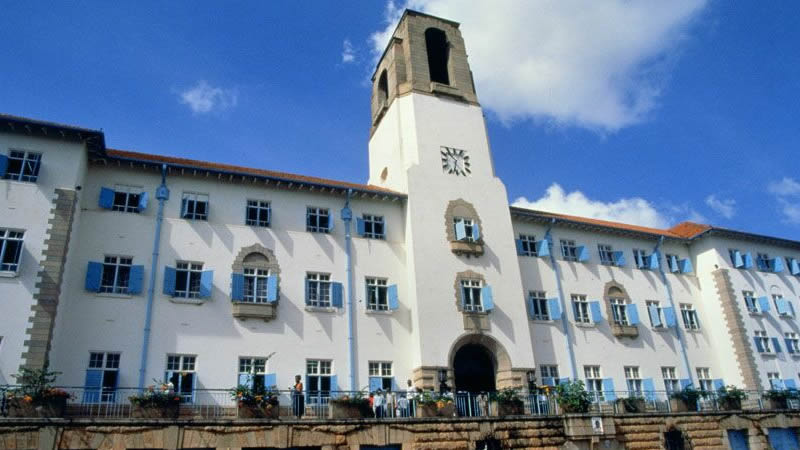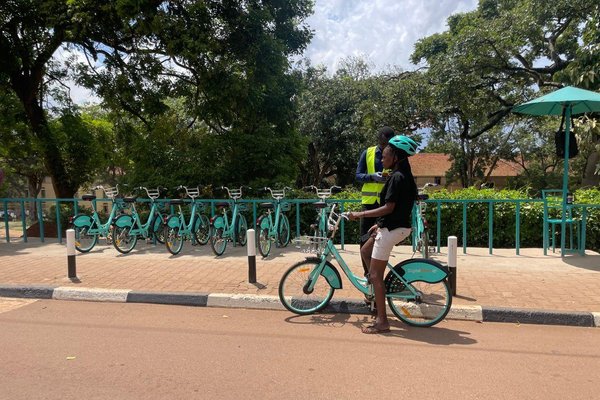By Mark Wamai
Whereas the summer school was aimed at enabling graduate students, researchers and professionals derive meaning from the huge amounts of data they work with, the workshop featured paper presentations and panel discussions centered on using data science methods to solve problems in African communities.
Why would such a gathering be of interest to the Makerere AI Lab, one may wonder. The answer lies in the intricate relationship between Data Science, Artificial Intelligence and Machine Language. “Simply put, Data Science is the exploration of huge amounts of data with the aim of gaining a deeper understanding,” explained Mutembesa, before adding “Artificial Intelligence is the general umbrella of technologies concerned with teaching machines to mimic certain human actions”.

Dr. Rose Nakasi (Left) and Mr. Daniel Mutembesa (Right) prepare to attach a smart phone on a microscope in the Makerere AI Lab.
“Machine Learning is modeling computer algorithms and coaching them using datasets of images or sounds with the aim of empowering them to predict or identify those unique attributes about an object when deployed in a real world setting,” he added.
A three-step approach
The Makerere AI research group has, since its founding around the year 2009, been guided by a three-tier approach: 1) identify a pressing local problem, 2) match that problem to a good computational solution, and 3) attach the project to the local beneficiary communities.
With this approach, the lab has been able to develop groundbreaking innovations to solve problems in agriculture, health, traffic monitoring, credit scoring and natural language processing.
“Data is more than simply the new gold,” says Mutembesa. “It is a resource that is immeasurable in terms of the potential it holds, not only for improving livelihoods through impactful solutions, but also generating revenue” he adds.
The Makerere AI Lab has been at the forefront of some groundbreaking innovations, which have unfortunately not been met with the attention and advocacy required to take them to the next level.
Helping farmers
For example, in agriculture, the Makerere AI Lab in partnership with the National Agricultural Research Organisation (NARO) and Uganda National Farmers Federation conducted extensive crowdsourcing of plants affected by cassava mosaic disease or whitefly infestations. Crowdsourcing was helpful for the partners to map out areas where disease outbreaks or infestations were happening in real-time. Beyond simply diagnosing affected plants, the lab took it a notch higher and used light spectrometry to non-invasively identify or classify the kinds of diseases before disease outbreaks. This innovation empowers the farmers to quickly manage the rapid spread of severe diseases by uprooting and burning the affected crops and replanting affected parts of the garden within the favourable season, as opposed to losing an entire field due to late diagnosis.
Beyond crop pests and disease diagnosis, the lab has in the past come up with Kudu, an application to connect farmers to potential buyers using SMS technology with AI automatically doing the decision-making. “Basically, on one end you have a farmer with produce to sell who sends a message with the quantities and farm gate price, and on the other end you have a willing buyer who sends their requests to a central place.
“At this point, the machine learning algorithm at the center matches the most potential buyer, and the most potential seller, based on the proximity of the price, geographical distance, to multiple other features. Of course, this gets better and better as you have more data coming in,” explained Mutembesa. So successful was a Kudu pilot that in 2013, the platform recorded seller and buyer requests worth over US$1 million.
In addition, the lab has also come up with a solution to use AI coupled with social data to make credit scoring accessible for historically unbanked smallholder farmers. This implies that farmers who have never opened a bank account can access credit facilities thanks to a socially generated reputation from their peers and community leaders.
Beyond the farmer-facing applications, the lab has supported the agricultural experts in building machine learning tools for the next generation of cassava breeding projects by automating the long and tedious processes crop-breeding experts go through to identify and eliminate diseased varieties during breeding trials. Furthermore, the lab has automated the prediction of flesh-colour and mealiness of boiled sweet potato roots. Given the prevailing shortage of expertise in the field, such innovations led to faster turnaround times for breeding programmes as AI could be deployed to inform and quicken the selection of promising genotypes that can be progressed for evaluation during crop breeding cycles.
Detecting disease
Staying with the need to provide affordable solutions in spaces with shortage of experts, the Makerere AI Lab has been at the forefront of developing a smart phone-based AI application to cut the time taken to diagnose malaria at Kiruddu and Mulago National Referral Hospitals from 30 to five minutes. The automation provided by the lab also helps eliminate one more problem - misdiagnosis due to eye fatigue by the lab technicians.
And whereas the lab went out with the objective of reducing malaria diagnosis times and reducing human error, upon taking one look at the images generated by the smartphone, the trainers of medical laboratory personnel had a eureka moment! These same images could be used to train more students simultaneously, as opposed to them taking turns to quickly peer down the eyepiece of the few and expensive microscopes.
“Our lab has also been able to use AI to predict the spatio-temporal patterns of malaria where mobility is a contributor,” added Mutembesa. Using aggregate-anonymised cell phone tower data from a telecom company, the lab was able to combine this with datasets of rainfall and temperature to develop a model that can predict where the next malaria outbreaks are likely to occur. Such interventions can be used by health agencies to prioritise the deployment of scarce human and drug resources as well as step up preventive measures.
The traffic problem
Traffic jams on the city roads as well as major highways are an increasingly common occurrence. These not only lead to a loss of productive time but also reduced air quality as exhaust fumes from vehicles build up along affected roads. The lab was able to develop smart low-cost devices, which, in partnership with the Kampala Capital City Authority (KCCA), were mounted along some roads. Following numerous “coaching” sessions using various datasets, the applications were not only able to identify a taxi from a lorry or a motorcycle from a cow, goat or dog crossing but also predict when traffic was likely to start building up. Empowered with such information, authorities are able to quickly dispatch scarce human resources to the spots where they are most needed or advise on alternative routes for motorists in the event of accidents. Additionally on environmental solutions, the lab has developed models to identify deforestation from satellite imagery, a necessity for government interventions.
Natural Language Processing (NLP) is another exciting field that the Lab is dealing with, whereby computers are trained to identify phrases in human language. Under NLP, the Lab used machine learning during the Covid-19 pandemic to monitor radio stations for sentiments and perspectives on topics such as vaccination, gender-based violence, relief efforts, and many more. “Our algorithms were trained to identify and eliminate music and adverts and only process speech that mentioned particular topics,” said Mutembesa. The ability for computers to automatically identify particular phases in human language makes NLP a particularly sensitive field with regard to ethics and privacy.
Researchers therefore ought to ensure that the privacy of human sources of data is protected and that the algorithms cannot be reverse-engineered to reveal identities. This is of utmost importance to Eric Peter Wairagala, another Research Scientist in the lab, and an area of focus in his current research.
“Language models need to be developed and deployed in a safe and responsible manner such that they respect the context of other communities and cultures,” he cautions.

A smart phone mounted on a microsope eyepiece and powered by an AI application developed by the Makerere AI Lab has automated the screening of blood samples for malaria, reducing diagnosis time from 30 to five minutes.
Hellen Namulinda, another research scientist in the lab with a keen interest in NLP is working to ensure that AI innovations are not blind to the unique Ugandan culture and its norms. “We need to have evaluation metrics and standards that are in line with indigenous and localised value systems that the language models can be tested against, rather than using western-based evaluation data,” she notes.
Beyond research opportunities for students of Computer Science or Information Technology, the Makerere AI Lab is a fertile ground for journalists and students of Journalism who are keen to report on all these new technologies shaping the Fourth Industrial Revolution (4IR). “We are ready and willing to receive students and practitioners in this space to help us tell our story to the world,” Mutembesa added.
From our conversation with the team at the Makerere AI Lab, it is clear that a lot more advocacy is needed to promote their amazing work. Beyond advocacy, there is a need for the right policy makers and environment to foster the translation of these innovations into prototypes that can be deployed to further entrench the place of the Makerere AI Lab as one of leaders on the African continent.
Related News
![]() Please join hands with the Makerere University Endowment Fund as it works towards attracting & retaining the best faculty, providing scholarships, and investing in cutting-edge research and technology.
Please join hands with the Makerere University Endowment Fund as it works towards attracting & retaining the best faculty, providing scholarships, and investing in cutting-edge research and technology.



